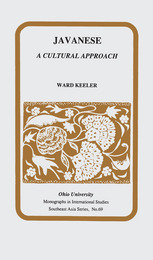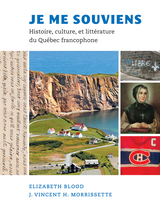4 start with J start with J

In this text, therefore, the sociological context of Javanese is explained as thoroughly as Javanese grammar. The book presents Javanese in its full complexity and range in order to illustrate a cultural appoach to a non-Western language; it will therefore be of interest not only to language learners, but to linguists, sociologists, anthropologists, and many others.

Je me souviens invites post-intermediate students of French to improve their language skills while exploring the complex history and culture of Québec.
Drawing on cultural products from the earliest days of exploration to the present day, Elizabeth Blood and J.Vincent H. Morrissette curate an array of texts that sample Québécois literature, popular culture, art, music, and politics and frame the texts with pre-reading and post-reading activities, cultural notes, and historical overview sections. The interdisciplinary approach challenges students to improve their French language skills while learning about Québec. Thematically organized writings delve into issues central to understanding the many facets of contemporary Québécois identity, while prompts direct students to search for a range of materials online. Je me souviens is an essential resource for students interested in understanding the francophone world.

Designed to be used simultaneously with Jusuur 1: Beginning Communicative Arabic, the Jusuur 1 Arabic Alphabet Workbook teaches students the letters, short vowels, and diacritics found in Arabic. As students learn new letters in the alphabet workbook, they strengthen their literacy skills through the reading and writing exercises in Jusuur 1.
A distinguishing feature of the Jusuur 1 Arabic Alphabet Workbook is that it introduces letters approximately in the order of letter frequency rather than in the traditional alphabetical order. This method, tested extensively in the classroom, enables students to begin to read and write meaningful phrases they are learning in Jusuur 1: Beginning Communicative Arabic as early as possible. Each letter section includes an introduction to the letter and its shapes and sound; space for writing practice; and activities to practice reading and dictation.
Features of the alphabet workbook include:-Authentic examples of language drawn from poetry, billboards, signs, and other sources to help students learn to identify letters -Samples of real Arabic handwriting, and guidance on recognizing and writing letters that look different when printed versus handwritten
Resources available on JusuurTextbook.com:-Audio files for dictation and listening exercises-Extensive instructor’s resources, including pedagogical notes, answers to activities, and recommendations for lesson and unit planning
By the end of the Jusuur 1 Arabic Alphabet Workbook, students will have learned all of the letters and sounds of the Arabic alphabet. Used in conjunction with Jusuur 1: Beginning Communicative Arabic, this workbook will give students a firm foundation in Arabic literacy to continue their studies.

Jusuur 1 presents a well-rounded curriculum that encourages active communication in Arabic from day one and is suitable for engaging students at a variety of levels including high school, community college, and four-year colleges.
Students learn the letters and sounds of Arabic with the accompanying Jusuur 1 Arabic Alphabet Workbook, while they simultaneously use Jusuur 1 to work through thematically organized lessons on such topics as greetings, hospitality, free time, and family. Jusuur 1 invites students to make the linguistic, social, and cultural connections key to language acquisition through carefully scaffolded vocabulary and grammar activities, cultural explanations, and frequent opportunities for reflection. A series of companion videos, filmed in Jordan, offers a unique introduction to common everyday interactions in the Arab world.
Jusuur 1 is the first of two books in the Jusuur Arabic Language Program; students who successfully finish the program will be able to communicate at novice-high or intermediate-low levels of proficiency.
The Jusuur curriculum, which draws from the pedagogical strengths of the best-selling Al-Kitaab Arabic Language Program, provides students with a wealth of written and audio-visual materials to develop skills in speaking, listening, reading, and writing. Instructors will benefit from extensive complementary instructor’s resources, including teacher’s guides, worksheets, and audio recordings, making it easy to design an enriching and engaging experience for students.
READERS
Browse our collection.
PUBLISHERS
See BiblioVault's publisher services.
STUDENT SERVICES
Files for college accessibility offices.
UChicago Accessibility Resources
home | accessibility | search | about | contact us
BiblioVault ® 2001 - 2024
The University of Chicago Press









